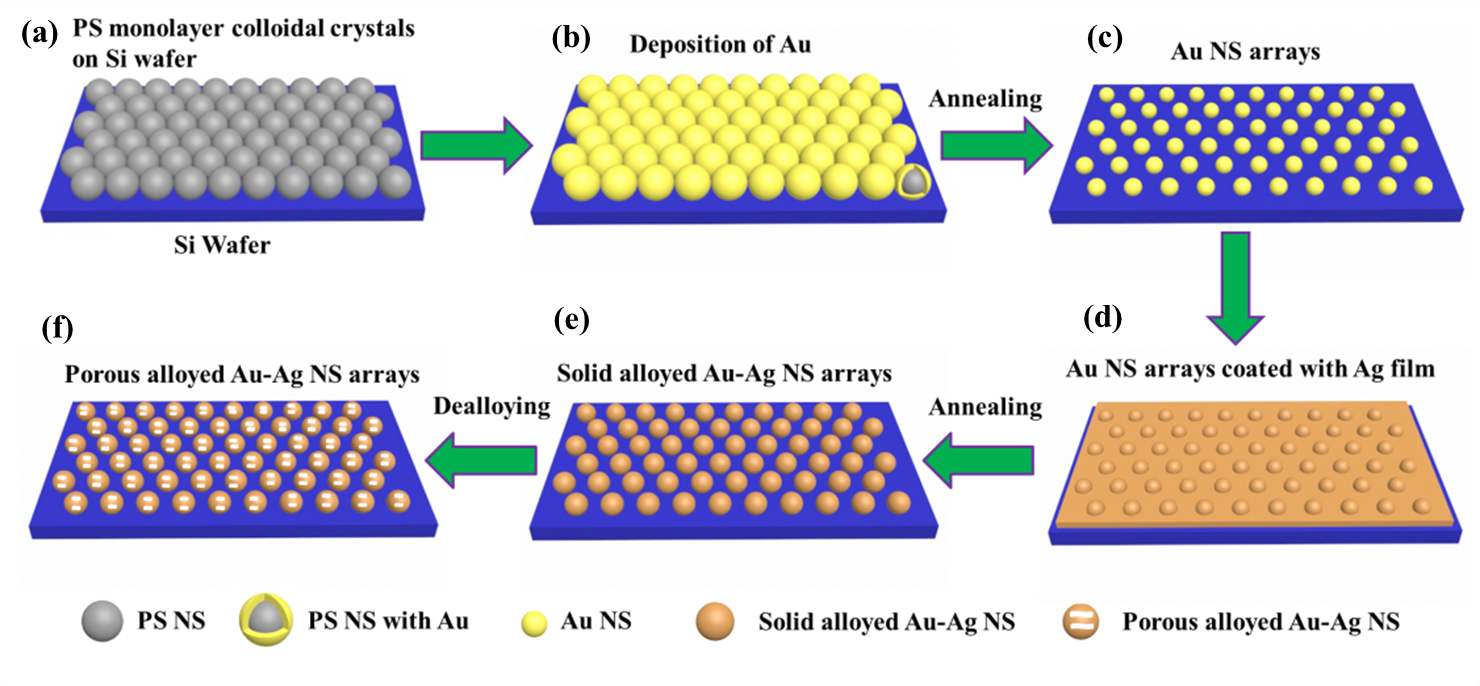Recently, a research team led by Prof. LI Yue in Institute of solid State Physics (ISSP), Hefei Institutes of Physical Science has revealed that the synthesized periodic porous alloyed Au-Ag nanosphere arrays showed highly sensitive SERS performance with good reproducibility.
Plasmonic noble metal nanoparticles (NPs) have received considerable attention because of their intense size- and shape-dependent localized surface plasmon resonance (LSPR) properties.
Recent studies have proven that Au-Ag nanosponges with tuned structures have excellent optical properties, large surface-to-volume ratio, high density of interior "hotspots" and enhanced electronic fields, which might improve their surface-enhanced Raman scattering, or SERS.
Therefore, various methods have been performed to fabricate porous Au-Ag nanomaterials which shows excellent SERS activities, but the reproducibility of their SERS performances on a large scale is still difficult to realize, which has substantially limited their further practical applications.
In this work, periodic porous alloyed Au-Ag nanosphere (NS) arrays with different periodic lengths and tunable composition ratios were prepared on Si substrates on a large scale (~ cm2) using stepwise metal deposition-annealing and subsequent chemical corrosion from a monolayer of colloidal polystyrene (PS) microspheres as the initial template for the first time.
The porous alloyed Au-Ag NSs possessed a high porosity and bicontinuous morphology composed of hierarchically interconnected ligaments, which were obtained from an optimized dealloying process in nitric acid. The periodic length of the array could be facilely changed by controlling the initial particle size of the PS template.
Moreover, the porous alloyed Au-Ag NS arrays were explored as a platform for the SERS detection of 4-aminothiophenol (4-ATP) and exhibited excellent reproducibility and high sensitivity due to the periodic structure of the arrays and the abundance of inherent "hotspots".
After optimization experiments, a low concentration of 10-10 M 4-ATP could be detected on these porous Au-Ag NS array substrates. Such highly reproducible SERS activity is meaningful for improving the practical application of portable Raman detection equipment.
This method can be used to fabricate other binary or ternary porous alloyed NP arrays with different elements. The presented strategy will be highly useful for the further development of various applications, including SERS-based analysis, dual-channel biosensors, energy storage, and catalysis.
The findings have been published online in ACS Applied Materials & Interfaces entitled Periodic Porous Alloyed Au-Ag Nanosphere Arrays and Their Highly Sensitive SERS Performance with Good Reproducibility and High Density of Hotspots.
This investigation was supported by The authors acknowledge financial support from the National Key Research and Development Program of China (Grant No. 2017YFA0207101), the Natural Science Foundation of China (Grant Nos. 51771188, 51371165, 51571189), the Cross-disciplinary Collaborative Teams Program in CAS.

Figure 1. Diagram depicting the synthesis of porous alloyed Au-Ag NS array. (a) Monolayer of colloidal PS crystals self-assembled on a Si wafer in an hcp arrangement. (b) Deposited thin film of Au on the monolayer of colloidal PS crystals. (c) Au NS array in an hncp arrangement obtained after annealing at 1000 °C for 2 h. (d) Deposited thin film of Ag on the Au NS array. (e) Solid alloyed Au-Ag NS array fabricated via thermal annealing of the substrate in (d) at 600 °C for 2 h. (f) Porous alloyed Au-Ag NS arrays constructed by the dealloying process.(Image by ZHANG Tao)

Figure 2. (a) Low- and (d) high-magnification FESEM images of the as-obtained sample after dealloying for 60 min; the inset of (a) shows a digital photograph of the as-prepared sample; the inset of (b) shows one typical unit. (c) Low-magnification TEM image of the Au-Ag NSs. (d) TEM image of a single unit with higher magnification. (e) Local HRTEM image of the area in the red frame in (d). (f) Corresponding FFT pattern of the area in (e). (g) HAADF-STEM image of a single unit. (h-i) EDS elemental maps of (e) Au and (f) Ag. (Image by ZHANG Tao)

Figure 3. (a) Raman signals of 4-ATP with a concentration of 10-6 M on the porous alloyed Au-Ag NS array, Au NS array, and solid alloyed Au-Ag NS array. (b) Raman map of 4-ATP on the porous alloyed Au-Ag NS array with a step size of 5 μm (integral time: 1 s; laser power: 1 mW). (c) Raman intensity distribution on the porous alloyed Au-Ag NS array, exhibiting a standard deviation of 7.7%. (d) Raman spectra of 4-ATP concentrations from 10-6 M to 10-10 M on the porous alloyed Au-Ag NS array. (Image by ZHANG Tao)
Contact:
ZHOU Shu
Hefei Institutes of Physical Science (http://english.issp.ac.cn/)
Email: zhous@hfcas.ac.cn
 Tel: +86-551-65591206
Tel: +86-551-65591206
 Fax: +86-551-65591270
Fax: +86-551-65591270
 Emai: zhous@hfcas.ac.cn
Emai: zhous@hfcas.ac.cn
 350 Shushanhu Road
350 Shushanhu Road